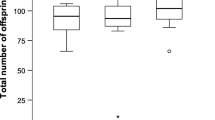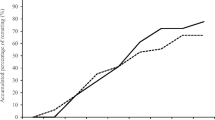Abstract
Virgin males (or females) of some species ofDrosophila, when stored singly, are known to be superior in mating to males (or females) stored in groups. This may create a spurious rare-male effect on some occasions. When no account is taken of this storage effect in an experimental setup designed to show rare-male mating advantage, bias in favor of a raremale effect may result. It is shown that merely by storing the rare males singly and the common males in groups, with males not differing in any other respect, a very strong spurious rare-male effect can be produced. Similarly, it is shown that a spurious rare-female effect is possible too. It is proposed that the very strong rare-male effect for pepperment scent as found by Dal Molin [(1979).Am. Nat. 113:951–954] is merely a result of such a bias. The relevance for natural populations of the mating advantage associated with the single housing condition is discussed. In the experiments designed to show a spurious rare-male effect, mating chambers of two different sizes were used. It is shown that sexual selection is more severe in the small chambers, for both males and females.
Similar content being viewed by others
References
Alvarez, G., Santos, M., and Zapata, C. (1984). Frequency-dependent selection arising from inappropriate fitness estimation.Evolution 38:696–699.
Anderson, W. W., and Brown, C. J. (1984). A test for rare male mating advantage withDrosophila pseudoobscura karyotypes.Genetics 107:577–589.
Barras, R. (1961). A quantitative study of the behaviour of the maleMormoniella vitripennis (Walker) (Hymenoptera, Pteromalidae) towards two constant stimulus-situations.Behaviour 18:288–312.
Barras, R. (1962). Contacts between males inMormoniella vitripennis (Walker)Hymenoptera: Pteromalidae.Anim. Behav. 10:385.
Bastock, M., and Manning, A. (1955). The courtship ofDrosophila melanogaster.Behaviour 8:85–111.
Bennet-Clark, H. C., Ewing, A. W., and Manning, A. (1973). The persistence of courtship stimuli inDrosophila melanogaster.Behav. Biol. 8:763–769.
Bryant, E. H., Kence, A., and Kimball, K. T. (1980). A rare-male advantage in the housefly induced by wing clipping and some general considerations forDrosophila.Genetics 96:975–993.
Dal Molin, C. (1979). An external scent as the basis for a rare-male mating advantage inDrosophila melanogaster.Am. Nat. 113:951–954.
Ehrman, L. (1966). Mating success and genotype frequency inDrosophila.Anim. Behav. 14:332–339.
Ehrman, L. (1967). Further studies on genotype frequency and mating success inDrosophila.Am. Nat. 101:415–424.
Elens, A. A., and Wattiaux, J. M. (1964). Direct observation of sexual isolation.Dros. Info. Serv. 39:118–119.
Ellis, L. B., and Kessler, S. (1975). Differential posteclosion housing experiences and reproduction inDrosophila.Anim. Behav. 23:949–952.
Goux, J. M., and Anxolabéhère, D. (1980). The measurement of sexual isolation and selection: A critique.Heredity 45:255–262.
Jacobs, M. E. (1960). Influence of light on mating ofDrosophila melanogaster.Ecology 41:182–188.
Knoppien, P. (1985a). Rare male mating advantage: A review.Biol. Rev. 60:81–117.
Knoppien, P. (1985b). The number of males stored per vial, a possible source of bias in rare male experiments.Dros. Info. Serv. 61:101.
Leonard, J. E., and Ehrman, L. (1983). Does the rare male advantage result from faulty experimental design?Genetics 104:713–716.
Manning, A. (1967). The control of sexual receptivity in femaleDrosophila.Anim. Behav. 15:239–250.
Markow, T. A. (1980). Rare male advantages amongDrosophila of the same laboratory strain.Behav. Genet. 10:553–556.
Maynard Smith, J. (1956). Fertility, mating behaviour and sexual selection inDrosophila subobscura.J. Genet. 54:261–279.
O'Donald, P., and Majerus, M. E. N. (1984). Polymorphism of melanic ladybirds maintained by frequency-dependent sexual selection.Biol. J. Linn. Soc. 23:101–111.
Partridge, L., and Gardner, A. (1983). Failure to replicate the results of an experiment on the rare male effect inDrosophila melanogaster.Am. Nat. 122:422–427.
Petit, C. (1958). Le déterminisme génétique et psycho-physiologique de la compétition sexuelle chezDrosophila melanogaster.Bull. Biol. Fr. Belg. 92:248–329.
Petit, C., Bourgeron, P., and Mercot, H. (1980). Multiple matings, effective population size and sexual selection inDrosophila melanogaster.Heredity 45:281–292.
Pot, W., Van Delden, W., and Kruijt, J. P. (1980). Genotypic differences in mating success and the maintenance of the alcohol dehydrogenase polymorphism inDrosophila melanogaster: No evidence for overdominance or rare genotype mating advantage.Behav. Genet. 10:43–58.
Pruzan, A. (1976). Effects of age, rearing and mating experiences on frequency-dependent sexual selection inDrosophila pseudoobscura.Evolution 30:130–145.
Robertson, H. M. (1982). Female courtship summation inDrosophila melanogaster.Anim. Behav. 30:1105–1117.
Sharp, P. M. (1982). Competitive mating inDrosophila melanogaster.Genet. Res. 40:201–205.
Siegel, R. W., Hall, J. C., Gailey, D. A., and Kyriacou, C. P. (1984). Genetic elements of courtship inDrosophila: Mosaic and learning mutants.Behav. Genet. 14:383–410.
Spiess, E. B. (1982). Do female flies choose their mates?Am. Nat. 119:675–693.
Spieth, H. T., and Ringo, J. M. (1983). Mating behavior and sexual isolation inDrosophila. In Ashburner, M., Carson, H. L., and Thompson, J. N. (eds.),The Genetics and Biology of Drosophila, Vol. 3c, Academic Press, London, pp. 223–284.
Van den Berg, M. J. (1985). The influence of isolation during rearing on male vigor inD. melanogaster.Dros. Info. Serv. 61:179.
Van den Berg, M. J., Thomas, G., Hendriks, H., and Van Delden, W. (1984). A reexamination of the negative assortative mating phenomenon and its underlying mechanism inDrosophila melanogaster.Behav. Genet. 14:45–61.
Von Schilcher, F. (1976). The role of auditory stimuli in the courtship ofDrosophila melanogaster.Anim. Behav. 24:18–26.
Author information
Authors and Affiliations
Rights and permissions
About this article
Cite this article
Knoppien, P. Rare-male mating advantage: An artifact caused by differential storage conditions?. Behav Genet 17, 409–425 (1987). https://doi.org/10.1007/BF01068139
Received:
Accepted:
Issue Date:
DOI: https://doi.org/10.1007/BF01068139




